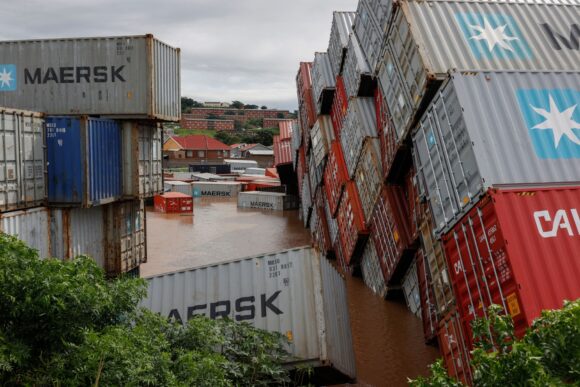South Africa’s deadliest floods in almost three decades was exacerbated by climate change and similarly heavy rainfall can be expected to occur more regularly, according to scientists collaborating under the World Weather Attribution initiative.
Rainfall in the southeastern KwaZulu-Natal province exceeded 350 millimeters (14 inches) over two days in some areas — the heaviest in at least six decades — triggering floods and landslides that killed 435 people, destroyed thousands of dwellings, cut power and water supplies, and disrupted trade at the Port of Durban, sub-Saharan Africa’s biggest container hub.
“The study estimates that that the probability of such an event happening has nearly doubled due to climate change caused by greenhouse gas emissions,” World Weather Attribution said a statement on Friday. “An extreme rainfall episode such as this one can now be expected to happen about once every 20 years.”
Update: South Africa’s Deadliest Floods in 6 Decades Claim More Than 300 Lives
The study adds to evidence that Africa is suffering the most from global warming. Adverse weather events, from cyclones to droughts, are hitting the continent more frequently than in the past and shifts in rain patterns are disrupting crucial agriculture.
In a study released last month World Weather Attribution tied the cyclones and tropical storms that have hit Madagascar and Mozambique this year to climate change.
“As the atmosphere becomes warmer it can hold more water, increasing the risk of downpours,” the group said. “With further greenhouse gas emissions and continued temperature increases heavy rainfall episodes will become even more common and intense.”
In South Africa, the deluge disproportionately affected the poorest people as most of those who died were living in shanty towns, known in locally as informal settlements.
While White-minority rule ended in 1994, an apartheid strategy that compelled poor Black Citizens to live on the margins of cities hasn’t been remedied and this played a major role in the disproportionate impact on those living in poverty.
“The setup is deeply rooted in structural inequalities across the grid where people have been forced to live in unsuitable areas,” Christopher Jack, deputy director at the Climate System and Analysis Group at the University of Cape Town, said on a conference call. “Even though apartheid was formally dismantled years ago, these structural inequalities persist and we still see them manifest and magnified when events such as these occur and added to this is the more recent history of rapid urban growth.”
The floods struck a wide area including the city of Durban, South Africa’s third-biggest with a population of almost four million people.
“The socioeconomic losses associated with this event were significant in terms of lives lost, casualties and damage to infrastructure,” World Weather Attribution said in the study. “Critical infrastructure such as bridges and roads were also severely damaged, including two major highways.”
Photograph: A general view of containers that fell over at a container storage facility following heavy rains and winds in Durban, on April 12, 2022. Photo credit: Phill Magakoe/AFP/Getty Images
Related:
Topics Flood Climate Change
Was this article valuable?
Here are more articles you may enjoy.



 Big ‘I’ Report: Independent Agency Channel Placed 62% of Premiums in 2023
Big ‘I’ Report: Independent Agency Channel Placed 62% of Premiums in 2023  Cyber Insurance Market ‘Stable’ With Potential for Growth, Says AM Best
Cyber Insurance Market ‘Stable’ With Potential for Growth, Says AM Best  US P/C Insurers Post Best Q1 Underwriting Result In 17 Years
US P/C Insurers Post Best Q1 Underwriting Result In 17 Years  ‘Great Resignation’ Enters Third Year as Workers Embrace AI, Upskilling, PwC Says
‘Great Resignation’ Enters Third Year as Workers Embrace AI, Upskilling, PwC Says 

